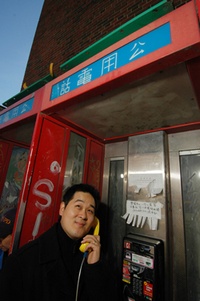Tak Toyoshima’s Asian American-themed comic strip, Secret Asian Man, is now nationally syndicated in major newspapers across the United States.
But even with daily, widespread circulation of his strips, which often touch on topics of race relations and diversity, Toyoshima says that there’s a lot about Asian Americans that the general public is still not seeing.
“The emasculated Asian male stereotype bothers me a lot,” says Toyoshima. “Not only because it implies Asian guys are not attractive but because it implies we are not capable of anything heroic. Superman is masculine and heroic. Denzel Washington is masculine and heroic. Jackie Chan is bumbling and has a weird nose. The funny thing is every time I bring this point up, Asian Americans will bring up notable Asians like John Cho, Jin, Russell Wong and Dustin Nguyen. You know who those people are notable to? Asian Americans! John Cho is great, but he’s not Hugh Jackman or Christian Bale. Keanu Reeves may be the closest we’ve come since the days of Sessue Hayakawa.”
For Toyoshima, the frustration about the marginalization of Asian Americans is longstanding. But finding ways to convey his thoughts to wide audiences—without losing the edgy, irreverent quality that makes his comic strip memorable—has been a creative challenge, especially as Secret Asian Man (SAM) began appearing in more family-friendly, mainstream publications.
“This year marks Secret Asian Man’s tenth anniversary and the strip has evolved a lot,” Toyoshima notes. “The development period right after I was picked up for syndication by United Features was the toughest adjustment for me. Besides the fact that I would be producing more strips in one year than I would have in the past seven years combined, there were also the challenges of adjusting the tone of the strip and developing a cast of characters. The tone used to be a lot more venomous and nasty. I would constantly swear and freely use racial slurs and insults. That doesn’t fly very well in daily newspaper land.”
“Asian American themes are certainly present in the strip but I have become a lot better, I think, at presenting them in a way that does not seem forced or overly preachy,” says Toyoshima. “Recently I have started to really enjoy working in social commentary into story lines as opposed to having the commentary be the story line. Most of us experience or observe things like racism, sexism, homophobia, etc., when we are doing something completely unrelated. When things like that happen while another story is being told, it feels more natural.”
Reactions to the comic strip, Toyoshima says, have varied widely. But he notes, “If there is one thing that I’m willing to bet my readers do more than they do to other most other comic strip artists is qualify what they are. ‘As a middle aged, white woman from Tennessee...’ It’s pretty funny how specific they can get.”
Toyoshima also mentions that a number of readers have been curious about the meaning behind strip’s title.
“Secret Asian Man started as a play on the Johnny Rivers song ‘Secret Agent Man,’” says Toyoshima. “At the time I thought it was a funny title and I just ran with it. Over the years many different meanings have been attributed to it. Some say SAM is ‘secret’ because he has assimilated into white American society. Other say he is secret because he is spying on America for an unnamed Asian country. And still others believe SAM is secret because he is so Americanized that there’s nothing typically Asian about him. So I suppose if there is an irony to the name, it’s that there is no secret.”
While a bit of mystery stirs interest in the strip, thinking up such a large volume of ideas and story lines is a challenge that Toyoshima sometimes finds daunting. But while there is pressure in producing a steady stream of work, Toyoshima is also discovering ways to use the serial nature of the daily comic strip to create richer stories.
“At first I popped out a lot of one-shot comic strips, meaning I’d pick a topic to write about and then turn it into one day’s worth of comics,” Toyoshima recalls. “I have since learned that there is no rush if I want to talk about something. Instead of trying to cram a whole lot of insight into a daily strip, I now find it more rewarding—for me and the readers—to take my time and deliver a good series of strips that will make my original point even stronger. I am currently working on the longest story arc I’ve ever written and I’m having a blast with it!”
For inspiration, Toyoshima draws upon his influences from both sides of the Pacific. “I grew up reading comic books, both American and Japanese, so I have many art heroes that I look up to,” he says. “Among them are Akira Toriyama, Tezuka Osamu, Katsuhiro Otomo, Hayao Miyazaki, Frank Miller, Sam Kieth, Frank Frazetta, Jack Kirby...I could go on for hours.”
“I am also certainly inspired by both of my artistic parents as well as my older brother whose artistic skills I grew up being jealous of,” Toyoshima adds. “My dad, Soroku Toyoshima, was one of a few neo-Dadaist artists coming out of Japan during the 1950s and 1960s, and has shown his work at the Tokyo Museum as well as a number of other shows in Japan and NYC.”
Creativity and individuality, says Toyoshima, not only ran in his family but also were encouraged. “My artistic parents definitely support my comic strip although I do remember a time when they were cautioning me about the life of an artist. I went to college to get a degree in advertising and I think they were somewhat relieved when I chose a professional path. But once I started to pursue an artistic career they have been nothing but supportive. They’d come to comic book conventions and ask for autographs. It was very nice. They even let me and my brother draw on the walls!”
“I remember when I was in high school reading books about Yukio Mishima,” says Toyoshima. “I asked my dad if he knew who he was and he told me, ‘I used to see him walking around town in fishnet shirts.’ That was pretty cool to me.”
“Becoming a dad to a half-Japanese/half-European boy—and another one on the way in October—has really made me reflect on my upbringing,” Toyoshima notes. “I do my best to teach my son what little Japanese I know and there are certain Japanese influences like all the Miyazaki movies he has watched that are a natural part of our family. I definitely do want him to have an appreciation for his culture but I’m walking a fine line between what he seems to enjoy and what I want him to know.”
“And the number one thing I want Secret Asian Man’s readers to know is that I need them to help the strip get into more and more papers,” says Toyoshima. “There are many editors who are hesitant. The newspaper industry in general is in turmoil and uncertainty, which makes it harder for an editor to take a chance on a new strip. But one thing they will respond to is feedback from their readers!”
* * *
Tak Toyoshima is also being featured in a new book: Secret Identities: The Asian American Superhero Anthology, edited by Jeff Yang, Parry Shen, Keith Chow, and Jerry Ma. The 200-page book, published by New Press, is the first comprehensive collection of stories featuring Asian American superheroes and includes contributions from dozens of Asian American artists and authors.
© 2009 Japanese American National Museum







